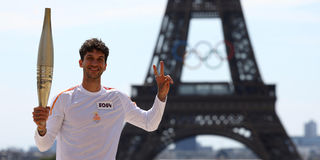Olympic torch gets to destination, setting stage for high-profile action

French BMX rider Matthias Dandois poses with the Olympic flame in front of the Eiffel Tower at the Trocadero on July 15, 2024.
What you need to know:
- According to the organisers, 20 public facilities have been renovated for the Olympics and 4,000 homes created on the Athletes Village and Media Village sites.
- Four new schools have been created that will cater for 1,800 children with 400,000 citizens benefitting directly from the Games’ legacy programmes that have cost the French organisers 10.67 million Euros (Sh1,5 billion).
In Paris
For almost three months from May 8 to today, over 10,000 Olympic Torchbearers carried the Olympic torch after it was lit in Olympia, Greece.
It is still unclear who will light the Olympic cauldron which stays alight for the duration of the Games.
Speculation is high that French triple Olympic gold medal-winning track star Marie-Jose Perec, Netflix star Omar Sy, ‘Les Bleus’ football legend Zinedine Zidane and French astronaut Thomas Pesquet could be considered.
US rapper Snoop Dogg is also lined up to carry the torch in its final stages with the head of the Paris 2024 Local Organising Committee Tony Estanguet early telling journalists here that the person to light the cauldron with flames from the Olympic torch is yet to be informed.
The Olympic torch was lit on April 16 in Olympia, Greece, the home of the Olympics, before it was shipped to Marseille in Southern France.
International Olympic Committee President Thomas Bach is particularly excited by the youth and gender appeal of the Paris 2024 Olympics, the first to run under IOC’s “Olympic Agenda 2020” that seeks to, inter alia, push for credibility, sustainability and youth appeal.
The “Olympic Agenda 2020” features 40 sets of recommendations whose goal is to safeguard the Olympic values and strengthen the role of sport in society.
“The Games will be more inclusive, more sustainable, more urban and more youthful,” Bach says.
“For the first time at an Olympic Games, full gender parity will be achieved on the field of play because IOC allocated 50 percent of the places to women and 50 percent to men,” he noted.
The Paris Games are also huge on legacy and sustainability with 95 percent of venues for the Games either existing or temporary, with carbon emissions limited to about half of what was the case at the London 2012 and Rio 2026 Games.
“Ensuring a long-term legacy has been a key part of the Games’ organization… the organisers have sought to ensure a strong social legacy not just in Paris, but throughout France,” Bach says.
According to the organisers, 20 public facilities have been renovated for the Olympics and 4,000 homes created on the Athletes Village and Media Village sites.
Four new schools have been created that will cater for 1,800 children with 400,000 citizens benefitting directly from the Games’ legacy programmes that have cost the French organisers 10.67 million Euros (Sh1,5 billion).




